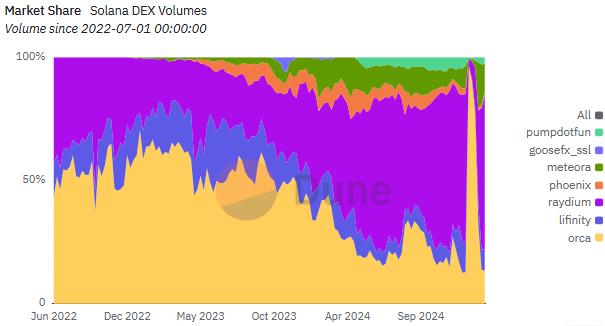Market
State of DEXs in 2025 Highlights Solana, Asia, AI & Crypto

A recent OKX report examined the state of decentralized exchanges (DEXs) in 2025, revealing Solana as a dominant force while Ethereum faces challenges to maintain its relevance.
The report highlighted how innovations across blockchains, technological advancements, and evolving user preferences have collectively reshaped the DEX sector.
Solana Leads the DEX Revolution
The Solana ecosystem is a key highlight in the OKX exchange’s report. It has emerged as a dominant force in decentralized finance (DeFi), commanding 48% of the total DEX volume. According to the State of DEXs in 2025, this growth can be attributed to its high-speed transaction capabilities, negligible fees, and developer-friendly infrastructure.
“By almost all measures of blockchain adoption, Solana blows every other chain out of the park. Network transaction fees generated, transaction count, active wallet addresses, DEX active users – Solana is truly the retail chain,” read an excerpt in the report.
Further, OKX cites Solana’s architectural advantages, which have also attracted traders and developers, creating a strong ecosystem for decentralized trading. A prime example of this success is Raydium, Solana’s flagship automated market maker (AMM). As BeInCrypto reported, Raydium recently dominated Solana DEX volume.

Raydium has established itself as a key player in Solana’s DeFi ecosystem by pioneering innovative liquidity provision models. The OKX report notes that Raydium’s efficient liquidity pooling has become a standard for DEX platforms, posing a direct challenge to Ethereum and its derivatives.
The report also highlights that users are increasingly gravitating toward Solana due to its lower transaction costs and faster speeds. This shift has pressured Ethereum to expedite the rollout of Ethereum 2.0 to remain competitive.
As Solana continues to gain momentum, OKX highlights Ethereum’s efforts to stay relevant with the launch of Ethereum 2.0. The upgrade aims to deliver reduced fees, improved scalability, and a smoother user experience. Additionally, innovations such as Uniswap’s v4, featuring modular “hooks” and a gas-efficient singleton architecture, have strengthened Ethereum’s competitive edge.
“The impact of Ethereum 2.0 on DEXs is two-fold. Firstly, Ethereum itself is now more optimal for DeFi applications. Secondly, L2s can now settle on Ethereum more cheaply with data blobs, allowing them to pass on significant cost savings to users, and making existing DEXs on L2s much cheaper to use,” OKX added.
Uniswap’s evolution illustrates Ethereum’s resilience in adapting to market demands. Introducing time-weighted average market makers (TWAMMs) and dynamic fees has improved liquidity management. These innovations, combined with reduced costs and performance improvements, position Ethereum as a critical player in the DEX ecosystem despite growing competition.
Decentralized Derivatives and AI Take the Spotlight
While spot trading remains central to DEX activity, the OKX report finds decentralized derivatives as the prospective next frontier in DeFi. Despite their potential, derivatives face liquidity fragmentation and regulatory challenges. Platforms like dYdX and Synthetix lead the charge, optimizing throughput, fees, and liquidity tools to create better trading environments.
A key innovation in this sector is comparing hard liquidity-backed models and synthetic approaches. The former relies on substantial liquidity pools to back derivatives, while the latter leverages algorithmic mechanisms to simulate liquidity. Both models have their trade-offs, but their continued development will likely shape the future of decentralized derivatives.
The integration of artificial intelligence (AI) into crypto has progressed in unexpected ways. On-chain AI agents enhance trading strategies, while AI-powered tools stream operations across DEX platforms. Additionally, the rise of AI-driven meme coins has demonstrated how these technologies can engage new audiences, potentially driving adoption in the DeFi space.
“One of the biggest questions of the Crypto X AI intersection is why crypto is needed…The answer to that question lies in the ability of crypto to customize incentive mechanisms and have a blockchain as an immutable data record,” OKX said.
Asia Takes the Lead Amid Shifting Developer Dynamics
A noteworthy trend in OKX’s state of DEXs in 2025 is the shift in crypto development hubs. Per the report, Asia has overtaken North America as the epicenter of innovation in the DEX ecosystem. BeInCrypto recently reported that Singapore and Hong Kong are leading the blockchain revolution over the US.
According to the OKX report, regulatory flexibility, an active developer community, and increasing regional institutional interest drive this change. The implications of this shift are profound, as Asia’s leadership is likely to influence the direction of DEX development in the coming years.
Meanwhile, the report acknowledges that liquidity remains the lifeblood of any DEX. Attracting liquidity providers (LPs) and ensuring sufficient capital in liquidity pools are critical challenges for emerging platforms. Uniswap, for instance, set the standard for liquidity provisioning with its AMM design. Its v3 model introduced concentrated liquidity, significantly improving capital efficiency but adding complexity.
Incentives have proven crucial in overcoming the “bootstrap problem.” For example, SushiSwap’s liquidity mining programs forced Uniswap to reevaluate its approach. This competitive pressure highlights the importance of balancing incentives to attract LPs while maintaining economic sustainability.
The OKX report concludes that the future of DEXs depends on achieving a balance where all stakeholders — traders, liquidity providers (LPs), token holders, and developers — gain value. Larger liquidity pools enable low-slippage trades, attracting more users, while well-designed incentive structures ensure long-term participation from LPs. To succeed, platforms must carefully navigate trade-offs to build ecosystems that drive both growth and innovation.
Disclaimer
In adherence to the Trust Project guidelines, BeInCrypto is committed to unbiased, transparent reporting. This news article aims to provide accurate, timely information. However, readers are advised to verify facts independently and consult with a professional before making any decisions based on this content. Please note that our Terms and Conditions, Privacy Policy, and Disclaimers have been updated.
Market
Report Alleges Massive Meme Coin Sniping on Pump.fun

According to a new report from Pine Analytics, token deployers on Pump.fun systematically funded sniper wallets to buy their own meme coins. This impacted over 15,000 token launches on the platform.
These sniper wallets operated primarily during US trading hours, executing standardized, profitable strategies. Unrelated bot activity obscures their behavior, making it extremely difficult to isolate these wallets—and they can readily adapt to new countermeasures.
Snipers Roam Free on Pump.fun Meme Coins
Pump.fun has remained one of the most popular meme coin launchpads on Solana despite persistent controversies and other criticism.
However, Pine Analytics’ new report has uncovered a new controversy, discovering systematic market manipulation on the platform. These snipes include as much as 1.75% of all launch activity on Pump.fun.
“Our analysis reveals that this tactic is not rare or fringe — over the past month alone, more than 15,000 SOL in realized profit was extracted through this method, across 15,000+ launches involving 4,600+ sniper wallets and 10,400+ deployers. These wallets demonstrate unusually high success rates (87% of snipes were profitable), clean exits, and structured operational patterns,” it claimed.
Solana meme coin deployers on Pump.fun follow a consistent pattern. They fund one or more sniper wallets and grant them advance notice of upcoming token launches.
Those wallets purchase tokens in the very first block and then liquidate almost immediately—85% within five minutes and 90% in just one or two swap events.

Pump.fun meme coin developers exploit this tactic to create the appearance of immediate demand for their tokens. Retail investors, unaware of the prior sell‑off, often purchase these tokens after the snipe, giving developers an unfair advantage. This constitutes market manipulation and erodes trust in the platform.
Pine Analytics had to carefully calibrate its methods to identify genuine snipers. Apparently, 50% of meme coin launches on Pump.fun involve sniping, but most of this is probably bots using the “spray and pray” method.
However, by filtering out snipers with no direct links to developer wallets, the firm missed projects that covered their tracks through proxies and burners.
In other words, the meme coin community does not have adequate defenses against systematic abuse on Pump.fun. There are a few possible ways that the platform could flag repeat offenders and sketchy projects, but adaptive countermeasures could defeat them. This problem demands persistent and proactive action.
Unfortunately, it may be difficult to enact such policies. Meme coin sniping is so systematic that Pump.fun could only fight it with real commitment.
Analysts think that building an on-chain culture that rewards transparency over extraction is the best long-term solution. A shift like that would be truly seismic, and the meme coin sector might not survive it.
Disclaimer
In adherence to the Trust Project guidelines, BeInCrypto is committed to unbiased, transparent reporting. This news article aims to provide accurate, timely information. However, readers are advised to verify facts independently and consult with a professional before making any decisions based on this content. Please note that our Terms and Conditions, Privacy Policy, and Disclaimers have been updated.
Market
Solana Leads Blockchain Metrics as SOL Momentum Builds

Solana (SOL) continues to show strength across multiple fronts, maintaining a bullish structure on its Ichimoku Cloud chart while gaining momentum in key market metrics. The BBTrend indicator has turned higher again, signaling renewed buying pressure after a brief cooldown.
On-chain activity remains strong, with Solana leading all blockchains in DEX volume and dominating fee generation thanks to the explosive growth of meme coins and launchpad activity. With SOL now trading above a key resistance level, the path is open for further upside—though a loss of momentum could still trigger a retest of lower supports.
Solana Maintains Bullish Structure, but Momentum Faces Key Test
On Solana’s Ichimoku Cloud chart, the price is currently above the Kijun-sen (red base line) but has dipped below the Tenkan-sen (blue conversion line), signaling weakening short-term momentum.
The flattening Tenkan-sen and price behavior suggest possible consolidation or the early stages of a pullback. Still, with the price holding above the Kijun-sen, medium-term support remains intact.

The overall Ichimoku structure remains bullish, with a thick, rising cloud and leading span A well above span B—indicating strong underlying support.
If Solana finds support at the Kijun-sen and climbs back above the Tenkan-sen, the uptrend could regain strength; otherwise, a test of the cloud’s upper boundary may follow.

Meanwhile, Solana’s BBTrend is currently at 6, extending nearly ten days in positive territory after peaking at 17.5 on April 14. The recent increase from 4.26 to 6 suggests renewed bullish momentum following a brief cooldown.
BBTrend, or Bollinger Band Trend, tracks the strength of price movement based on Bollinger Band expansion.
Positive values like the current one point to an active uptrend, and if the BBTrend continues to rise, it could signal stronger momentum and potential for another upward move.
Solana Dominates DEX Volume and Fee Generation as Meme Coins Drive Ecosystem Growth
Solana has once again claimed the top spot among all chains in DEX volume, recording $15.15 billion over the past seven days. The combined total of Ethereum, BNB, Base, and Arbitrum reached $22.7 billion.

In the last 24 hours alone, Solana saw $1.67 billion in volume, largely fueled by its booming meme coin ecosystem and the ongoing launchpad battle between PumpFun and Raydium. Adding to this good momentum, Solana recently surpassed Ethereum in Staking Market Cap.

When it comes to application fees, Solana’s momentum is just as clear. Four of the top ten fee-generating apps over the past week—PumpFun, Jupiter, Jito, and Meteora—are Solana-focused.
Pump leads the pack with nearly $18 million in fees alone.
Solana Breaks Key Resistance as Uptrend Targets Higher Levels, but Risks Remain
Solana has finally broken above its key resistance at $136, flipping it into a new support level that was successfully tested just yesterday.
Its EMA lines remain aligned in a bullish setup, suggesting the uptrend is still intact.
If this momentum continues, SOL price could aim for the next resistance zones at $147 and $152—levels that, if breached, open the door to a potential move toward $179.

The current structure favors buyers, with higher lows and strong support reinforcing the trend.
However, if momentum fades, a retest of the $136 support is likely.
A breakdown below that level could shift sentiment, exposing Solana to deeper pullbacks toward $124 and even $112.
Disclaimer
In line with the Trust Project guidelines, this price analysis article is for informational purposes only and should not be considered financial or investment advice. BeInCrypto is committed to accurate, unbiased reporting, but market conditions are subject to change without notice. Always conduct your own research and consult with a professional before making any financial decisions. Please note that our Terms and Conditions, Privacy Policy, and Disclaimers have been updated.
Market
Crypto Firms Donated $85 million in Trump’s Inauguration

According to a new report, 15 firms and individuals from the crypto industry donated more than $100,000 to President Trump’s Inauguration, totaling over $85 million.
Almost all of these companies apparently received direct or indirect benefits from Trump’s administration. This includes dropped legal proceedings, lucrative business partnerships, participation in Trump’s Crypto Summit, and more.
Crypto Industry Went All-In on Trump’s Inauguration
Since promising to bring friendlier regulations on the campaign trail, Donald Trump attracted a reputation as the Crypto President.
Trump’s Inauguration festivities included a “Crypto Ball,” and several prominent firms made donations for these events. Today, a report has compiled all crypto-related contributions of over $100,000, revealing some interesting facts.

Since taking office, President Trump and his family have been allegedly involved in prominent crypto controversies, and these donations may be linked to several of them.
For example, eight of the donors, Coinbase, Crypto.com, Uniswap, Yuga Labs, Kraken, Ripple, Robinhood, and Consensys, had SEC investigations or lawsuits against them closed since Trump’s term began.
The commission might have dropped its probe against these companies anyway due to its changing stance on crypto enforcement. However, being in the President’s good books likely helped the process.
Further Alleged Benefits for Donors
In other words, nearly half the firms that made donations to Trump’s Inauguration have seen their legal problems cleared up quickly. This isn’t the only regulation-related benefit they allegedly received.
Circle, for example, recently made an IPO after openly stating that Trump’s Presidency made it possible. Galaxy Digital received SEC approval for a major reorganization, a key step for a NASDAQ listing.
Other donors, such as Crypto.com and ONDO, got more direct financial partnerships with businesses associated with the Trump family.
Previously, Ripple’s CEO, Brad Garlinghouse, anticipated a crypto bull market under Trump. Also, XRP, Solana, and Cardano were all unexpectedly included in the US Crypto Reserve announcement.
All three of these companies made major donations to Trump’s Inauguration.
It seems that most of the firms involved got at least some sort of noticeable benefit from these donations. Donors like Multicoin and Paradigm received invitations to Trump’s Crypto Summit, while much more prominent groups like the Ethereum Foundation got snubbed.
Meanwhile, various industry KOLs and community members have already alleged major corruption in Trump’s crypto connections.
While some allegations might lack substantial proof, the crypto space has changed dramatically under the new administration, for both good and bad.
Disclaimer
In adherence to the Trust Project guidelines, BeInCrypto is committed to unbiased, transparent reporting. This news article aims to provide accurate, timely information. However, readers are advised to verify facts independently and consult with a professional before making any decisions based on this content. Please note that our Terms and Conditions, Privacy Policy, and Disclaimers have been updated.




















